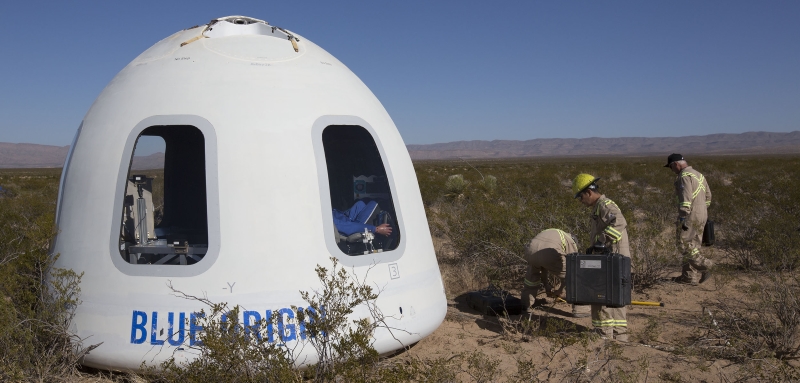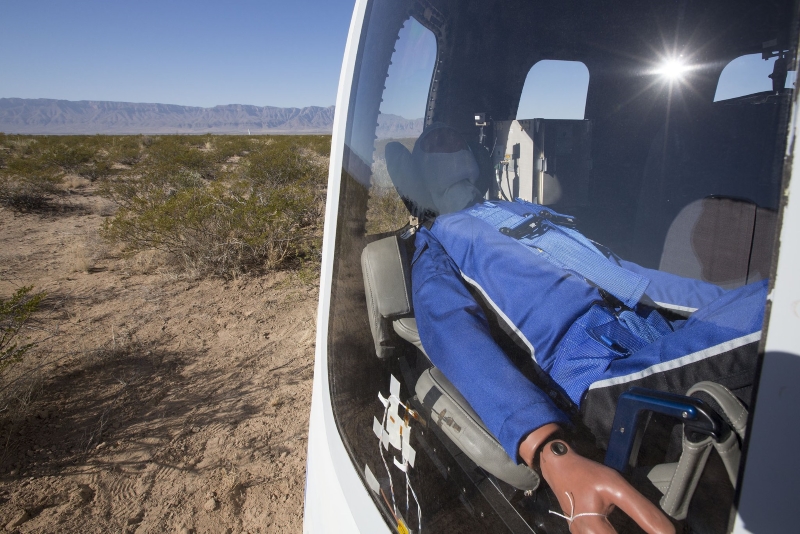Flying at New Shepard First Person
On December 12, in a situation of almost secrecy, the flight of the New Shepard suborbital tourism system took place, in which a new rocket and a second version of the ship with huge portholes were successfully tested. Also for the first time, footage from cameras inside a capsule was published, which can be used to evaluate the experience of future suborbital tourists.

Blue Origin Photo
If two past times, Blue Origin delighted us with webcasts of the entire flight, now, probably from reinsurance, the launch was not covered in real time, and the materials were published only after the successful completion of the tests.
But this time for the first time we were shown a full video of the flight, captured from inside the capsule. The benefit of its second version was equipped with simply giant windows 0.7 x1.1 meters. The main role was played by Mannequin Skywalker (“Star Walker”, but this is an obvious reference to “Star Wars”, and we decided not to translate the name of Luke).
Now, for some reason, Blue Origin did not impose flight data on the video, but, knowing the timing of the last flight in summer 2016, the sounds heard in the cockpit can be easily deciphered.
0:07 Start
1:35 The change in sound due to the thinning of the atmosphere is noticeable.
2:25 Shutting down the engine, comes weightlessness - in the capsule you can see flying small debris.
2:42 The ship is separated from the rocket, the garbage (mainly ice) is visible outside the capsule.
4:50 You can notice the drag on the atmosphere.
5:29 The air becomes so thick that sound appears. There are also disturbances that are parried by the control system of the capsule, at 5:55 the orientation engines work is perfectly visible.

8:06 Shooting brake parachute covers, brake parachutes are produced.
8:20 Main parachutes are released and opened.
10:04 Just before the touch, the brake motors come on, thanks to which the landing looks quite soft. According to the measurements of Blue Origin, the capsule touched the ground at a speed of only 1.6 km / h.

The view of the capsule after landing, the portholes seem simply huge. Most likely, strain gauges for measuring glass deformation are fixed on the tape. Blue Origin Photo
Formally, in this flight, the capsule did not reach space, because the maximum height of its ascent was 98.27 km, but the test is definitely successful - both the rocket and the capsule made a soft landing and are ready for repeated flights. In addition to the dummy in the ship were 12 commercial, research and educational experiments, which received about two and a half minutes of this weightlessness. The entire flight took 10 minutes and 6 seconds.
Separately, it is worth noting that the large windows make it possible to tickle the nerves until the end of the flight - the capsule swings quite noticeably, and just before the landing itself, the earth approaches frighteningly quickly. But the real danger is minimal, of all Blue Origin competitors look the most reliable, they have already successfully tested in real flights the failure scenarios of one of the parachutes and the emergency rescue system.
In his tweet, Bezos asked to ignore the squeaking sound - this was one of the experiments. By the way, it’s hard to say whether the noise in the cabin is uncomfortable - the fact is that we don’t know its initial level (in the video we could both reduce and increase), the capsule definitely flew without a final finish, which can have sound-absorbing layers, and The camera on a hard mount was getting a distorted picture, because the sound was going through the metal.
Bezos continues to insist that passengers will have the opportunity to unfasten themselves and swim around the capsule - obviously, the windows are considered strong enough to withstand an accidental impact, and gradually increasing overload will allow time to take their places.
The latest news - on Twitter, we were shown a robot for the landing pad.
Unfortunately, Blue Origin does not like PR, so we only know about the intention to launch a person for the first time in 2018, without a detailed plan and test dates. There is information that another version of the ship will be built, in this case, the launch with a man is likely to take place in the second half of the year. However, with the gained speed and the experience already gained on the reuse of the rocket and the ship, it is worth waiting for a more active launch schedule.

Blue Origin Photo
If two past times, Blue Origin delighted us with webcasts of the entire flight, now, probably from reinsurance, the launch was not covered in real time, and the materials were published only after the successful completion of the tests.
But this time for the first time we were shown a full video of the flight, captured from inside the capsule. The benefit of its second version was equipped with simply giant windows 0.7 x1.1 meters. The main role was played by Mannequin Skywalker (“Star Walker”, but this is an obvious reference to “Star Wars”, and we decided not to translate the name of Luke).
Now, for some reason, Blue Origin did not impose flight data on the video, but, knowing the timing of the last flight in summer 2016, the sounds heard in the cockpit can be easily deciphered.
0:07 Start
1:35 The change in sound due to the thinning of the atmosphere is noticeable.
2:25 Shutting down the engine, comes weightlessness - in the capsule you can see flying small debris.
2:42 The ship is separated from the rocket, the garbage (mainly ice) is visible outside the capsule.
4:50 You can notice the drag on the atmosphere.
5:29 The air becomes so thick that sound appears. There are also disturbances that are parried by the control system of the capsule, at 5:55 the orientation engines work is perfectly visible.

8:06 Shooting brake parachute covers, brake parachutes are produced.
8:20 Main parachutes are released and opened.
10:04 Just before the touch, the brake motors come on, thanks to which the landing looks quite soft. According to the measurements of Blue Origin, the capsule touched the ground at a speed of only 1.6 km / h.

The view of the capsule after landing, the portholes seem simply huge. Most likely, strain gauges for measuring glass deformation are fixed on the tape. Blue Origin Photo
Formally, in this flight, the capsule did not reach space, because the maximum height of its ascent was 98.27 km, but the test is definitely successful - both the rocket and the capsule made a soft landing and are ready for repeated flights. In addition to the dummy in the ship were 12 commercial, research and educational experiments, which received about two and a half minutes of this weightlessness. The entire flight took 10 minutes and 6 seconds.
Separately, it is worth noting that the large windows make it possible to tickle the nerves until the end of the flight - the capsule swings quite noticeably, and just before the landing itself, the earth approaches frighteningly quickly. But the real danger is minimal, of all Blue Origin competitors look the most reliable, they have already successfully tested in real flights the failure scenarios of one of the parachutes and the emergency rescue system.
In his tweet, Bezos asked to ignore the squeaking sound - this was one of the experiments. By the way, it’s hard to say whether the noise in the cabin is uncomfortable - the fact is that we don’t know its initial level (in the video we could both reduce and increase), the capsule definitely flew without a final finish, which can have sound-absorbing layers, and The camera on a hard mount was getting a distorted picture, because the sound was going through the metal.
Bezos continues to insist that passengers will have the opportunity to unfasten themselves and swim around the capsule - obviously, the windows are considered strong enough to withstand an accidental impact, and gradually increasing overload will allow time to take their places.
The latest news - on Twitter, we were shown a robot for the landing pad.
Unfortunately, Blue Origin does not like PR, so we only know about the intention to launch a person for the first time in 2018, without a detailed plan and test dates. There is information that another version of the ship will be built, in this case, the launch with a man is likely to take place in the second half of the year. However, with the gained speed and the experience already gained on the reuse of the rocket and the ship, it is worth waiting for a more active launch schedule.
All Articles